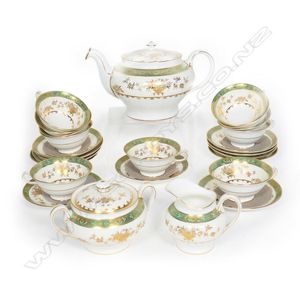Tiffany & Co. Mintons Porcelain Tea Set
Mintons for Tiffany & Co New York porcelain tea service, early 20th century, near complete 12 place, decorated with a green band and elaborate gilding. Includes 12 teacups, 11 saucers, teapot, sugar and creamer. gilded marks to each include Tiffany & Co., New York, made in England.
You must be a subscriber, and be logged in to view price and dealer details.
Subscribe Now to view actual auction price for this item
When you subscribe, you have the option of setting the currency in which to display prices to $Au, $US, $NZ or Stg.
This item has been sold, and the description, image and price are for reference purposes only.
- Dating English Ceramics - Excellent detailed reference books such as Godden's Encyclopaedia of British Pottery and Porcelain Marks will help to identify and date specific manufacturer's marks.
However, there are a few simple guidelines which may also help.
The inclusion of the word 'England' on an item ensured compliance with the American McKinley Tariff Act 1891, which was important for British exporters. An item so marked would have been made after 1891.
In 1921 the act was revised to require the phrase 'Made in' followed by the country. So if an item is marked 'Made in England', it is generally considered to be made after that date, although some manufacturers were using this phrase pior to the act being changed.
The use of the word 'Ltd' of 'Limited' after a company's name indicates a date after 1860, though with ceramic manufacturers this did not become general practice until the 1880's. - Gilding - Gilding is a method of ornamentation whereby a thin sheet of gold metal is applied to items made of wood, leather, ceramics, glass and silver for decorative purposes.
For furniture including mirrors, the sheet of gold is usually applied over a coating of gesso. Gesso is a mixture of plaster of Paris and gypsum mixed with water and then applied to the carved wooden frames of mirrors and picture frames as a base for applying the gold leaf. After numerous coats of gesso have been applied, allowed to dry and then sanded a coat of "bole", a usually red coloured mixture of clay and glue is brushed on and allowed to dry, after which the gold leaf is applied. Over time parts of the gilding will rub off so the base colour can be seen. In water gilding, this was generally a blue colour, while in oil gilding, the under layer was often yellow. In Victorian times, gilders frequently used red as a pigment beneath the gold leaf.
Metal was often gilded by a process known as fire gilding. Gold mixed with mercury was applied and heated, causing the mercury to evaporate, the long-term effect of which was to kill or disable the craftsman or woman from mercury poisoning. The pursuit of beauty has claimed many victims, not the least of which were the artists who made those pieces so highly sought after today.
This item has been included into following indexes:
-
Mintons Ltd. (England), items
- dinner ware 74
- tea sets 47
